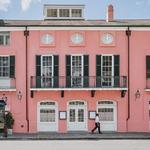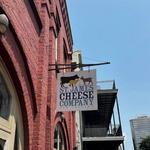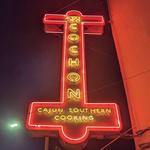WHITNEY & NATHANIELWHITNEY & NATHANIEL
Things To DoThings To Do

The Moonwalk Riverfront ParkThe Moonwalk Riverfront Park
Take a beautiful stroll along the Mississippi River as an introduction to the city! The French Quarter was originally designed with river access in mind, so the perspective of Jackson Square from the moonwalk resembles a lavish stage set to impress visitors. Additional views of Algiers Point across the river emphasize the interconnectedness of the city with the landscape. The moonwalk runs along reclaimed land built from naturally deposited river silt over a few hundred years- in 1718 you'd have been be swimming!

The Carousel Bar & LoungeThe Carousel Bar & Lounge
A must-do when visiting the French Quarter! Step inside the historic Hotel Monteleone and take a seat at the 1949 Carousel Bar- a real carnival carousel converted to a bar station which lights up and rotates. Bonus points for ordering a Sazerac, the official drink of New Orleans and the first "cocktail" in the U.S.
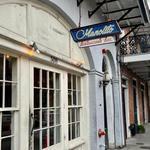
ManolitoManolito
The culture of New Orleans has a strong Caribbean influence which often gets overlooked in favor of European associations. Manolito's is a small hidden Cuban gem which makes the best mojitos and traditional daquiris in town and a solid Cuban sandwich. Limited space inside, take it on the go!
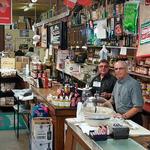
Central Grocery and DeliCentral Grocery and Deli
You want this. Newly reopened after damage from Hurricane Ida, this small Italian grocery is one of the few businesses remaining from the historic Italian neighborhood in the French Quarter. Central Grocery is a third generation, old-fashioned grocery founded in 1906 by Salvatore Lupo, a Sicilian immigrant famous for creating the muffuletta. Central is a treasure trove of imported snacks, dry ingredients, canned goods, meats, and cheeses. One muffuletta is enough for 2 people. That plus a daiquiri while sitting on the river is always a good time.
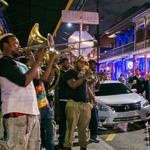
Frenchmen StreetFrenchmen Street
Locals prefer Frenchmen Street over Bourbon Street- it's less smelly and generally has fewer people. Aside from numerous famous music venues and bars featuring live music, Frenchmen also offers a late night art market in a courtyard under twinkling lights- be on the look out! Whitney's favorite places include Blue Nile, The Spotted Cat, and Three Muses. Spontaneous brass band performances in front of Dat Dog are always possible!

Ursulines ConventUrsulines Convent
The Old Ursulines Convent is the oldest historic building in the French Quarter and the oldest remaining French Colonial building in the U.S. You'd have to travel to Montreal to find another! There are some fun superstitions and legends about the convent related to ghosts and vampires (of course) but for any architecture or engineering nerds the interior structure is just as fun!
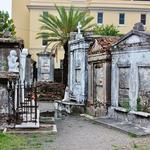
St. Louis Cemetery No. 1St. Louis Cemetery No. 1
New Orleans takes its graveyards very seriously. St. Louis Cemetery No. 1 was established in 1789 during Spanish colonization and is the oldest surviving cemetery in the city. The above-ground tombs characteristic of New Orleans were first implemented here in 1803 by city mandate due to the threat of constant flooding and the spread of disease. Marie Laveau's supposed tomb is located here but please do not mark or damage it. St. Louis Cemetery was added to the National Register of Historic Places in 1975 and later on the African American Heritage Trail in 2008 due to the high number of significance African American burials on site. Tours are now guided-only due to reoccurring vandalism of the historic tombs, so be sure to arrange a visit.
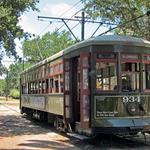
Scenic St. Charles Streetcar RideScenic St. Charles Streetcar Ride
Take a break and enjoy a scenic ride on the historic St. Charles Streetcar line between the French Quarter and the Carrolton neighborhood. Offers views of 19th and early 20th century mansions built by early New Orleans industrialists and a miles-long promenade of live oak trees. Download the New Orleans RTA transit app to upload passes for easiest access on and off the line. Note: the green streetcars not the red!

Cafe Du MondeCafe Du Monde
Although there is a Cafe du Monde location in the French Quarter it is well worth the effort to visit the City Park location in the historic Old Casino building! Along with fewer people and shorter lines, this Cafe du Monde location offers views of lazy lagoons, wildlife, centuries-old oak trees, and level paths for a nature stroll. The park is publicly accessible by the red Carrolton streetcar line and also by renting city Blue Bikes for an approx. fifteen minute ride down scenic Esplanade Avenue from the French Quarter.

The Sazerac HouseThe Sazerac House
A new addition to the city which has already made a name for itself. Consider a tour at Sazerac House for a guided tasting experience and exploration of New Orleans' cocktail traditions. Fun fact- the Sazerac is not only the official drink of the city but is also considered the country's first cocktail! A Sazerac tasting is about $30/each and a Whiskey tasting is about $45.

Parkway Bakery & TavernParkway Bakery & Tavern
Best po'boys in the city since 1911 and worth the wait if there's a line. Whitney's favorite is a half-and-half catfish and shrimp, fully dressed (shredded lettuce, tomato, mayo, and pickles) but the road beef and gravy is a local legend. Take it to go and sit on scenic St. Johns Bayou, a pre-historic waterway utilized by Native Americans and early colonists traveling between Lake Pontchartrain and the Mississippi River.

Audubon ParkAudubon Park
Audubon Park is a lush and inviting historic landscape built upon an ancient cypress swamp. The land was claimed as part of the Foucher plantation in the early 19th century. The city purchased the land in 1871 and it became host to the World's Industrial and Cotton Centennial Exposition of 1884. The park opened to the public in 1898 and was named for artist and naturalist John James Audubon who once lived in the area. The park is publicly accessible from the green St. Charles streetcar line and is located across from the historic Tulane University and Loyola campuses.
Magazine StreetMagazine Street
A historic commercial and residential district with 19th and early 20th buildings featuring a variety of shops and restaurants. A great place to spend a day looking at boutiques, drinking wine, eating, and strolling. The blocks between Louisiana Avenue and Felicity Street have the best offerings. Check out Peaches Records, The Bulldog, or Funky Monkey Vintage!
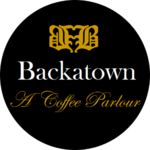
Backatown Coffee ParlourBackatown Coffee Parlour
This coffee shop sells a killer slice of cake, but is also located at the site of old Storyville, the city's legalized red light district in the late 19th and early 20th century. Storyville gave birth to legends such as Jelly Roll Morton, Louis Armstrong, and King Oliver. A single building from an early public housing development in this area has remained intact post-Katrina, and signage offer a wealth of information on the historic neighborhood and a glimpse into New Orleans' historic underbelly. St. Louis Cemetery No.1, one of the oldest in the city, is next door.

The National WWII MuseumThe National WWII Museum
A perfect place to spend some hours on a rainy day! You could spend days inside this massive museum complex simply learning, but the restaurant/bar inside is also delicious! Great crab cakes. In college Whitney was part of an archaeology program sponsored by the WWII Museum, so the facility and its programs are very dear to her heart!


